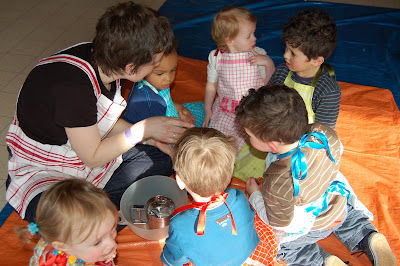kids workshop - Painting with the Nose - Babelut Festival 2008
a workshop by Kristina Andersen and Maki Ueda
Babelut Festival 2008, Neerpelt Belgium
It's a 30 minutes workshop for the kids age 1.5 to 3. The workshop consists of two parts: first half is about making the smelly paint with the spices and herbs, and the kids make the smelly paintings in the second half.
First we grind the spices and herbs like cardamon, lavender, and star anise into powder with a mortal. As they are ground, the room is filled with the delicious scents.

"Wow, look! There's the black seeds in the green peel... doesn't it smell great?"
"What does it smell of? Don't you think of the sweets?"


Then we add the custom-made paint base. It's made with the milk, cornstarch, and citric acid etc. (detailed recipe)



We are now ready to paint.


We had already prepared 16 different scented paints beforehand, and they are now to be used too.
* lavender (lavendel)
* green cardamon (kardemon)
* green tea Sencha (groene thee Sencha)
* coriander seed (korianderzaad)
* vanilla (vanille)
* juniper berry (jeneverbes)
* cinnamon (kaneel)
* star anise (steranijs)
* kentjoer
* kaffir lime leaves
* violets 3 colors (viooltjes 3 kleuren)
* aniseed (anijszaad)
* fennel seed (venkelzaad)
* clove buds (kruidnagel)
* nutmeg (nootmuskaat)
* ginger (gember)
* calendula flower (goudsbloem)









After finishing painting, the kids take the paintings back home together with the memories of the scents smelled in the workshop.




Most of the kids were interested in mixing the different scents on the paper, but this boy was totally obsessed by ginger. Perhaps he particularly liked the scent.



"Wow it looks like a poop!"
The parents also seem to have enjoyed the workshop very much.
If you close your eyes, you can actually trace the intensity of the scent with your nose. So it's like a map for your nose.

Babelut Festival 2008, Neerpelt Belgium
It's a 30 minutes workshop for the kids age 1.5 to 3. The workshop consists of two parts: first half is about making the smelly paint with the spices and herbs, and the kids make the smelly paintings in the second half.
First we grind the spices and herbs like cardamon, lavender, and star anise into powder with a mortal. As they are ground, the room is filled with the delicious scents.

"Wow, look! There's the black seeds in the green peel... doesn't it smell great?"
"What does it smell of? Don't you think of the sweets?"


Then we add the custom-made paint base. It's made with the milk, cornstarch, and citric acid etc. (detailed recipe)



We are now ready to paint.


We had already prepared 16 different scented paints beforehand, and they are now to be used too.
* lavender (lavendel)
* green cardamon (kardemon)
* green tea Sencha (groene thee Sencha)
* coriander seed (korianderzaad)
* vanilla (vanille)
* juniper berry (jeneverbes)
* cinnamon (kaneel)
* star anise (steranijs)
* kentjoer
* kaffir lime leaves
* violets 3 colors (viooltjes 3 kleuren)
* aniseed (anijszaad)
* fennel seed (venkelzaad)
* clove buds (kruidnagel)
* nutmeg (nootmuskaat)
* ginger (gember)
* calendula flower (goudsbloem)









After finishing painting, the kids take the paintings back home together with the memories of the scents smelled in the workshop.




Most of the kids were interested in mixing the different scents on the paper, but this boy was totally obsessed by ginger. Perhaps he particularly liked the scent.



"Wow it looks like a poop!"
The parents also seem to have enjoyed the workshop very much.
If you close your eyes, you can actually trace the intensity of the scent with your nose. So it's like a map for your nose.

Comments